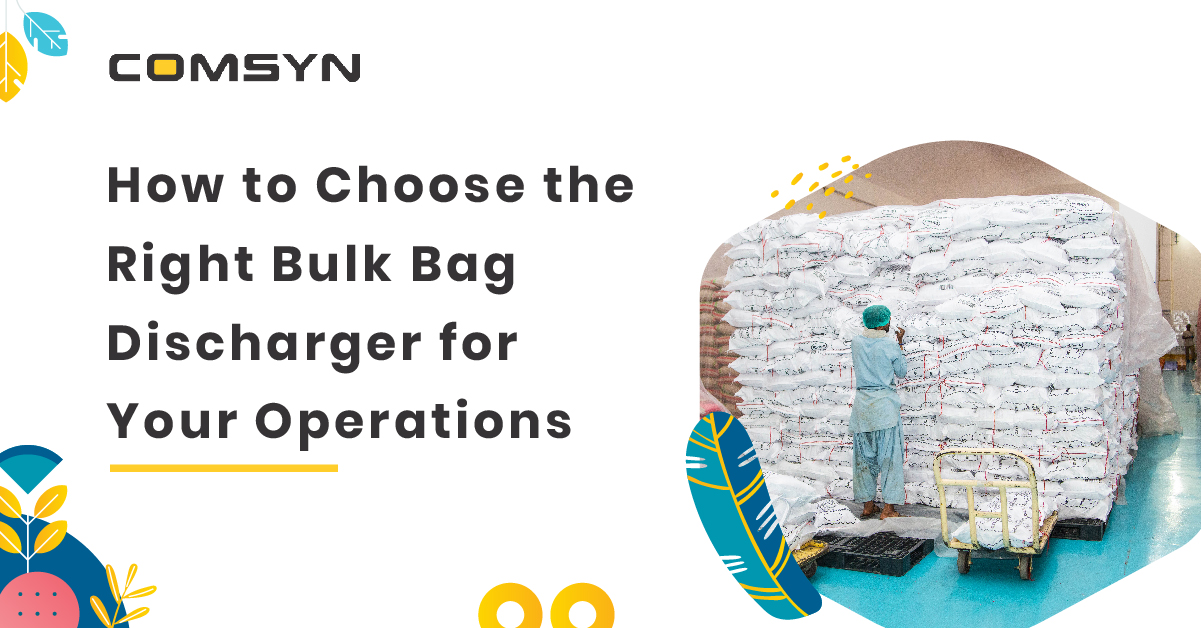This is where a bulk bag discharger or a bulk bag discharge station will be an essential piece of equipment. The use of a bulk bag discharge system spans multiple industries, but the goal of proper unloading is to ensure the flow of material is the most efficient, with little waste and without compromising for cleaner and safer work practices. At Comsyn, we know that material handling is paramount in any industry, and we can keep you in smooth and safe bulk bag discharge with a selection of high-quality FIBCs designed for efficient bulk bag discharge processes in any industry. A bulk bag, or Flexible Intermediate Bulk Container (FIBC), is a large, flexible container made of woven polypropylene fabric designed to collect and move dry bulk goods such as powders, granules, and agricultural products. Bulk bags are available as either coated or uncoated, with multiple lift options such as loops or sleeves, depending on the application. The bulk bag is being used for a variety of industries, ranging from food processing to construction, mainly because they can hold large loads (up to 2000 kg) while being very space-efficient. Selecting the appropriate bulk bag design is important to ensure easy and safe unloading. Here are the most common types: This is a basic construction with no outlet. The bag is cut open by hand to release the contents. Plain bottom bags are traditionally used as disposables or when dust is not an issue. The spout is a tapered-cylindrical part with a simple design that allows for the regulated flow of material. This is the most popular construction where simplicity does not compromise controlled discharge. Could be described as a work-horse when poor flow characteristics exist with your materials to direct the material into the spout while minimizing the chance of residual material. Full comfort and it will untie rapidly, allowing you to dump the bulk bag very quickly. Li8l’s involving quick dump or messy applications may be the best reason to use a duffle bag bottom. A diaper bottom bag has an overlapping flap with a reinforcing member on the base of the bag. Essentially, the flap is supporting an entire discharge. A spout is fitted with an additional flap (like a cover) that prevents contamination as well as dust control. This would be a major consideration when the application is sensitive, like for food or pharma applications. A system that closes securely around the spout in a free-adjustable manner, allowing for the best controlled and clean discharge processing. A bulk bag discharge station is generally made up of several structural components: The process for bulk discharge from a bulk bag involves several steps: There are numerous operational benefits to using a bulk bag discharger, which include: Bulk bag discharging stations play an important role in many industries: Comsyn offers a selection of FIBCs designed to work with the modern bulk bag discharge station. We offer spout, duffle, and conical spout FIBCs to help improve flow, strength, and cleanliness at discharge. By focusing on construction, contamination prevention, and flexibility, Comsyn bulk bags are used in industries that need the best bulk material handling solutions. Choosing the best bulk bag discharger and the best bag type is not just a purchase decision, it is part of designing an effective operation. By matching the discharge system that is built for your material’s properties and satisfying your facility’s production needs, you will be more productive. Protecting your employees, your materials, and lowering your waste all have impacts on your bottom line. Q: How do I dispose of empty bulk bags? Q: How to unload bulk bags? Q: What is a self-discharging bulk carrier? Q: Are Comsyn bulk bags compatible with all discharge systems?How to Choose the Right Bulk Bag Discharger for Your Operations?

Bulk bags or Flexible Intermediate Bulk Containers (FIBCs) have changed how many industries store, handle, and transport dry flowable materials. When utilized properly, bulk bags and the machinery involved can positively impact the performance of a materials handling process. Proper machinery that can effectively unload bulk bags using the FIBC discharge systems operates to increase safety, time, and efficiency without compromising on performance. What is a Bulk Bag?
Types of Bulk Bag Discharge Designs
1. Plain Bottom Discharge
2. Spout Discharge
3. Conical Spout Discharge
4. Duffle Bottom
5. Diaper Bottom
6. Discharge Spout with Flap
7. Iris Closure System
Components of a Bulk Bag Discharge System
How Does a Bulk Bag Discharge System Work?
Benefits of Using Bulk Bag Discharge Systems
Industrial Applications
Comsyn’s Bulk Bag Discharge Solutions
Conclusion
FAQs
Empty bulk bags should be folded and sent for recycling, if they’re made from recyclable materials like polypropylene. Always check local recycling guidelines.
Bulk bags are unloaded using discharge stations or spouts. Simply release the bottom spout or cut the base to allow material flow in a controlled manner.
It’s a transport system equipped with built-in unloading mechanisms. These carriers automatically release bulk material without external equipment.
Yes, Comsyn bulk bags are designed for versatility and work seamlessly with most standard discharge systems and bulk handling setups.
- About Us
- Products
- Markets Served
-
- Investor Relation
- Board Of Directors
- Committees Of Board
- Corporate Governance
- Financials
- Annual Report
- Key Managerial Positions
- Shareholding Pattern
- Notices
- Policies Programme
- Announcements
- Statement of Investor Complaints
- Unpaid & Unclaimed Dividend
- Prospectus
- Investors Contact
- Subsidiary Financials
- IEPF
- Preferential Issue – 2024
- MOA & AOA
- Integrated Filing
- Sustainability
- Contact Us
- TechTex
- Brochure

